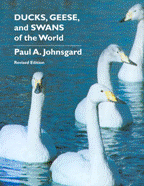Papers in the Biological Sciences

Ducks, Geese, and Swans of the World by Paul A. Johnsgard
Date of this Version
2010
Document Type
Front/Back Matter
Abstract
Inasmuch as the primary purpose of this book is to provide information on each of the species of the waterfowl family in a standardized format and easily accessible manner, it is important that the reader have some knowledge of the basis for my sequential organization of these species. A variety of attempts to provide a "natural" classification, or one that best reflects actual evolutionary relationships, of the family Anatidae have been made in recent years, with most of them being minor variations on a scheme first proposed by Jean Delacour and Ernst Mayr in 1945. In this landmark classification, emphasis was given to the association of species at the tribal level, rather than to the fragmentation of the family into a large number of subfamilies, as in earlier classifications.
My own behavioral studies of the family resulted in a proposed classification for the group in 1961, which was utilized in my subsequent books (1965a, 1968a) and has been subject to only minor modification since that time based on new information from my own and other studies. In brief, the family Anatidae is here regarded to be composed of 3 subfamilies, 13 tribes, 43 genera, and 148 recent species as follows:
Family Anatidae (ducks, geese, and swans)
Subfamily Anseranatinae
Tribe Anseranatini: Magpie goose (1 genus and species)
Subfamily Anserinae
Tribe Dendrocygnini: Whistling or tree ducks (2 genera, 9 species)
Tribe Anserini: Swans and true geese (4 genera, 21 species)
Tribe Cereopsini: Cape Barren goose (1 genus and species)
Tribe Stictonettini: Freckled duck (1 genus and species)
Subfamily Anatinae
Tribe Tadornini: Sheldgeese and Shelducks (5 genera, 15 species)
Tribe Tachyerini: Steamer ducks (1 genus, 3 species)
Tribe Cairinini: Perching ducks (9 genera, 13 species)
Tribe Merganettini: Torrent duck (1 genus and species)
Tribe Anatini: Dabbling or surface-feeding ducks (4 genera, 39 species)
Tribe Aythyini: Pochards (3 genera, 16 species)
Tribe Mergini: Sea ducks (8 genera, 20 species)
Tribe Oxyurini: Stiff-tailed ducks (3 genera, 8 species)
These groups are believed to be related to one another in the manner shown in figure 1, which indicates the probable relationships of the 13 tribes and 43 genera recognized in this book. Similar diagrams showing species relationships for each of the major tribes have been published earlier (Johnsgard, 1961a), and with relatively few more recent modifications still provide the basis for the sequence in which individual species are considered in this book. Behavioral and anatomical characteristics that provide the basis for the association of these species into tribes and subfamilies are those which are regarded as particularly significant, and thus it is worth reviewing such "emergent" characteristics before the species- by-species consideration of the entire family.

